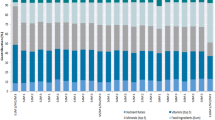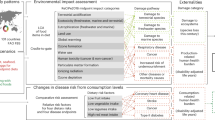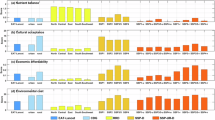Abstract
Research on sustainable diets has primarily focused on human and planetary health, neglecting workers in food value chains despite their high global employment and forced labour rates. Combining nationally representative food intake data and forced labour risk data for food commodities, we compared the risk of forced labour embedded in five diets in the USA—current diets, three US-specific recommended dietary patterns and the EAT–Lancet Planetary Health Diet. We find that forced labour risk is highest in the Mediterranean-Style and US-Style recommended patterns and lowest in the Planetary Health Diet pattern, with the biggest differences driven by intake of fruit, dairy and red meat. Protein foods account for nearly half of the risk in all patterns, except for the Healthy Vegetarian recommended pattern. These results point to potential synergies and trade-offs between human health, environmental sustainability and social well-being that should be considered in dialogue and action on sustainable diets.
This is a preview of subscription content, access via your institution
Access options
Access Nature and 54 other Nature Portfolio journals
Get Nature+, our best-value online-access subscription
$32.99 / 30 days
cancel any time
Subscribe to this journal
Receive 12 digital issues and online access to articles
$119.00 per year
only $9.92 per issue
Buy this article
- Purchase on SpringerLink
- Instant access to full article PDF
Prices may be subject to local taxes which are calculated during checkout





Similar content being viewed by others
Data availability
The detailed results and background data files are available for download via Zenodo at https://doi.org/10.5281/zenodo.16815633 (ref. 81). Source data are provided with this paper.
Code availability
Data processing and analysis were performed using R (v.4.4.0), Microsoft Excel (v.16.83), TableauPrep (v.2024.1) and TableauDesktop (v.2023.2.0). R scripts are available for download via Zenodo at https://doi.org/10.5281/zenodo.16815633 (ref. 81). The associated GitHub repository is located at https://github.com/brookembell/forced-labor.
References
Willett, W. et al. Food in the Anthropocene: the EAT–Lancet Commission on healthy diets from sustainable food systems. Lancet 393, 447–492 (2019).
Ridoutt, B., Anastasiou, K., Baird, D., Garcia, J. N. & Hendrie, G. Cropland footprints of Australian dietary choices. Nutrients 12, 1212 (2020).
Springmann, M. et al. Health and nutritional aspects of sustainable diet strategies and their association with environmental impacts: a global modelling analysis with country-level detail. Lancet Planet. Health 2, e451–e461 (2018).
Cambeses-Franco, C., González-García, S., Feijoo, G. & Moreira, M. T. Is the Paleo diet safe for health and the environment? Sci. Total Environ. 781, 146717 (2021).
Cambeses-Franco, C., González-García, S., Feijoo, G. & Moreira, M. T. Encompassing health and nutrition with the adherence to the environmentally sustainable new Nordic diet in southern Europe. J. Cleaner Prod. 327, 129470 (2021).
Chen, C., Chaudhary, A. & Mathys, A. Dietary change scenarios and implications for environmental, nutrition, human health and economic dimensions of food sustainability. Nutrients 11, E856 (2019).
Drew, J., Cleghorn, C., Macmillin, A. & Mizdrak, A. Healthy and climate-friendly eating patterns in the New Zealand context. Environ. Health Perspect. 128, 017007 (2020).
Fresán, U., Martínez-González, M. A., Sabaté, J. & Bes-Rastrollo, M. Global sustainability (health, environment and monetary costs) of three dietary patterns: results from a Spanish cohort (the SUN project). BMJ Open 9, e021541 (2019).
Springmann, M., Clark, M. A., Rayner, M., Scarborough, P. & Webb, P. The global and regional costs of healthy and sustainable dietary patterns: a modelling study. Lancet Planet. Health 5, e797–e807 (2021).
Webb, P. et al. Measurement of diets that are healthy, environmentally sustainable, affordable, and equitable: a scoping review of metrics, findings, and research gaps. Front. Nutr. 10, 1125955 (2023).
Blackstone, N. T. et al. Diets cannot be sustainable without ensuring the well-being of communities, workers and animals in food value chains. Nat. Food 5, 818–824 (2024).
Davis, B. et al. Estimating Global and Country-level Employment in Agrifood Systems FAO Statistics Working Paper Series 23–34 (FAO, 2023).
CO29 - Forced Labour Convention, 1930 No. 29 (ILO, 1932).
The Meanings of Forced Labour (ILO, 2014); https://www.ilo.org/resource/article/meanings-forced-labour
Global Estimates of Modern Slavery: Forced Labour and Forced Marriage (ILO, Walk Free Foundation & International Organization for Migration, 2022); https://publications.iom.int/books/global-estimates-modern-slavery-forced-labour-and-forced-marriage
Minkoff-Zern, L.-A. Hunger amidst plenty: farmworker food insecurity and coping strategies in California. Local Environ. 19, 204–219 (2014).
Minkoff-Zern, L.-A. & Sloat, S. A new era of civil rights? Latino immigrant farmers and exclusion at the United States Department of Agriculture. Agric. Hum. Values 34, 631–643 (2017).
Grzywacz, J. G. et al. Organization of work in the agricultural, forestry, and fishing sector in the US southeast: implications for immigrant workers’ occupational safety and health. Am. J. Ind. Med. 56, 925–939 (2013).
Soper, R. How wage structure and crop size negatively impact farmworker livelihoods in monocrop organic production: interviews with strawberry harvesters in California. Agric. Hum. Values 37, 325–336 (2020).
Blackstone, N. T., Norris, C. B., Robbins, T., Jackson, B. & Decker Sparks, J. L. Risk of forced labour embedded in the US fruit and vegetable supply. Nat. Food 2, 692–699 (2021).
Blackstone N. T. et al. Supplementary Information for: forced labor risk is pervasive in the US land-based food supply. Harvard Dataverse https://doi.org/10.7910/DVN/LEVNP2 (2023).
Blackstone, N. T. et al. Forced labour risk is pervasive in the US land-based food supply. Nat. Food 4, 596–606 (2023).
Reinhardt, S. L. et al. Systematic review of dietary patterns and sustainability in the United States. Adv. Nutr. 11, 1016–1031 (2020).
Serra-Majem, L. et al. Updating the Mediterranean diet pyramid towards sustainability: focus on environmental concerns. Int. J. Environ. Res. Public Health 17, 8758 (2020).
Beal, T., Ortenzi, F. & Fanzo, J. Estimated micronutrient shortfalls of the EAT–Lancet planetary health diet. Lancet Planet. Health 7, e233–e237 (2023).
LeBaron, G., Howard, N., Thibos, C. & Kyritsis, P. Confronting Root Causes: Forced Labour in Global Supply Chains (openDemocracy and the Sheffield Political Economy Research Institute, 2018); https://doi.org/10.13140/RG.2.2.35522.68807
Viederman, D. Urgent Action Against Forced Labour Is Possible. Here’s How (World Economic Forum, 2025).
US Tariffs: What’s the Impact on Global Trade and the Economy? (J.P. Morgan Research, 2025).
Lawreniuk, S. Trump’s tariffs: poor workers in countries like Cambodia will be among the biggest losers. Conversation (25 April 2025).
Emediegwu, L. Why Donald Trump’s trade tariffs are a threat to global food security. Conversation (1 May 2025).
Huizar, M. I., Arena, R. & Laddu, D. R. The global food syndemic: the impact of food insecurity, malnutrition and obesity on the healthspan amid the COVID-19 pandemic. Prog. Cardiovasc. Dis. 64, 105–107 (2021).
Waxman, E., Salas, J., Gupta, P. & Karpman, M. Food Insecurity Trended Upward in Midst of High Inflation and Fewer Supports: Findings from the Health Reform Monitoring Survey, June 2022 (Urban Institute, 2022).
Haeder, S. Massive cuts to Health and Human Services’ workforce signal a dramatic shift in US health policy. Conversation (31 March 2025).
De la Vega-Rivera, A. & Merino-Pérez, L. Socio-environmental impacts of the avocado boom in the Meseta Purépecha, Michoacán, Mexico. Sustainability 13, 7247 (2021).
Dehghan, S. K. Are Mexican avocados the world’s new conflict commodity? Guardian (30 December 2019).
Denvir, A., Arima, E. Y., González-Rodríguez, A. & Young, K. R. Ecological and human dimensions of avocado expansion in México: towards supply-chain sustainability. Ambio 51, 152–166 (2022).
Khan, N., Kakabadse, N. K. - & Skouloudis, A. Socio-ecological resilience and environmental sustainability: case of avocado from Mexico. Int. J. Sustain. Dev. World Ecol. 28, 744–758 (2021).
Magrach, A. & Sanz, M. J. Environmental and social consequences of the increase in the demand for ‘superfoods’ world-wide. People Nat. 2, 267–278 (2020).
Conrad, Z. et al. Diet sustainability analyses can be improved with updates to the food commodity intake database. Front. Nutr. 9, 868485 (2022).
Jarmul, S. et al. Climate change mitigation through dietary change: a systematic review of empirical and modelling studies on the environmental footprints and health effects of ‘sustainable diets’. Environ. Res. Lett. 15, 123014 (2020).
LeBaron, G. The role of supply chains in the global business of forced labour. J. Supply Chain Manage. 57, 29–42 (2021).
Billings, K. C. USDA’s Latest Update to Nutrition Standards for School Meals (Library of Congress, 2024); https://www.congress.gov/crs-product/R47522
Nutrition Standards in the National School Lunch and School Breakfast Programs (USDA Food and Nutrition Service, 2012).
C40 Food Systems wins the Food Planet Prize 2024, the $2-million environmental award, for making millions of meals in major cities healthier and more sustainable. Food Planet Prize https://foodplanetprize.org/news/c40-food-systems-wins-the-food-planet-prize-the-2-million-environmental-award-for-making-millions-of-meals-in-major-cities-healthier-and-more-sustainable/ (2024).
U.S. Government Trade Strategy to Combat Forced Labor: Making Trade a Force for Good by Addressing Forced Labor in Global Supply Chains (Office of the United States Trade Representative, 2025); https://ustr.gov/sites/default/files/U.S.%20Government%20Trade%20Strategy%20to%20Combat%20Forced%20Labor.pdf
Guiding Principles on Business and Human Rights: Implementing the United Nations ‘Protect, Respect and Remedy’ Framework (United Nations Human Rights, Office of the High Commissioner, 2011); https://www.ohchr.org/sites/default/files/documents/publications/guidingprinciplesbusinesshr_en.pdf
Chambers, R. & Birchall, D. How European human rights law will reshape U.S. business. UC Law Bus. J. 20, 57 (2024).
Wilks, S., Blankenbach, J. & Manschot, A. Respecting Human Rights: Why the CSDDD Needs to Go Beyond Social Auditing (Business and Human Rights Resource Centre, 2023).
Decker Sparks, J. L., Matthews, L., Cárdenas, D. & Williams, C. Worker-less social responsibility: how the proliferation of voluntary labour governance tools in seafood marginalise the workers they claim to protect. Mar. Policy 139, 105044 (2022).
Fair Food Program. Fair Food Program https://www.fairfoodprogram.org/ (2025).
Costa, D. & Martin, P. How much would it cost consumers to give farmworkers a significant raise? Economic Policy Institute: Working Economics Blog https://www.epi.org/blog/how-much-would-it-cost-consumers-to-give-farmworkers-a-significant-raise-a-40-increase-in-pay-would-cost-just-25-per-household/ (2020).
Acting against Forced Labour: An Assessment of Investment Requirements and Economic Benefits: Discussion Paper on the Economics of Forced Labour (ILO, 2024); https://doi.org/10.54394/TYLO1243
The Hands That Feed Us: Challenges and Opportunities for Workers Along the Food Chain (Food Chain Workers Alliance, 2012); https://foodchainworkers.org/wp-content/uploads/2012/06/Hands-That-Feed-Us-Report.pdf
The hands that feed us. Nat. Food 1, 93 (2020).
2022 List of Goods Produced by Child Labor or Forced Labor (US Department of Labor, 2022); https://www.dol.gov/sites/dolgov/files/ilab/child_labor_reports/tda2021/2022-tvpra-list-of-goods-v3.pdf
Human Rights Report: 2022 Country Reports on Human Rights Practices (US Department of State, 2023); https://www.state.gov/reports/2022-country-reports-on-human-rights-practices/
Trafficking in Persons Report (US Department of State, 2023); https://www.state.gov/wp-content/uploads/2022/04/337308-2022-TIP-REPORT-inaccessible.pdf
Bouwman, A. F. et al. Global hindcasts and future projections of coastal nitrogen and phosphorus loads due to shellfish and seaweed aquaculture. Rev. Fish. Sci. 19, 331–357 (2011).
Gephart, J. A. et al. Environmental performance of blue foods. Nature 597, 360–365 (2021).
MacLeod, M. J., Hasan, M. R., Robb, D. H. F. & Mamun-Ur-Rashid, M. Quantifying greenhouse gas emissions from global aquaculture. Sci. Rep. 10, 11679 (2020).
National Health and Nutrition Examination Survey Questionnaire (CDC & NCHS, 2015).
National Health and Nutrition Examination Survey Questionnaire (CDC & NCHS, 2017).
Dietary Guidelines for Americans, 2020–2025 9th edn (USDA & DHHS, 2020); https://www.dietaryguidelines.gov/resources/2020-2025-dietary-guidelines-online-materials
Dietary Guidelines Advisory Committee Scientific Report of the 2020 Dietary Guidelines Advisory Committee: Advisory Report to the Secretary of Agriculture and the Secretary of Health and Human Services (USDA & HHS, 2020); https://doi.org/10.52570/DGAC2020
Nissen, S. E. U.S. dietary guidelines: an evidence-free zone. Ann. Intern. Med. 164, 558–559 (2016).
Knuppel, A., Papier, K., Key, T. J. & Travis, R. C. EAT-Lancet score and major health outcomes: the EPIC-Oxford study. Lancet 394, 213–214 (2019).
Hu, E. A., Steffen, L. M., Coresh, J., Appel, L. J. & Rebholz, C. M. Adherence to the healthy eating index–2015 and other dietary patterns may reduce risk of cardiovascular disease, cardiovascular mortality, and all-cause mortality. J. Nutr. 150, 312–321 (2020).
Blackstone, N. T. & Conrad, Z. Comparing the recommended eating patterns of the EAT-Lancet Commission and eietary guidelines for Americans: implications for sustainable nutrition. Curr. Dev. Nutr. 4, nzaa015 (2020).
Conrad, Z., Reinhardt, S., Boehm, R. & McDowell, A. Higher-diet quality is associated with higher diet costs when eating at home and away from home: National Health and Nutrition Examination Survey, 2005-2016. Public Health Nutr. 24, 5047–5057 (2021).
Conrad, Z. et al. Relationship between food waste, diet quality, and environmental sustainability. PLoS ONE 13, e0195405 (2018).
Conrad, Z. Daily cost of consumer food wasted, inedible, and consumed in the United States, 2001–2016. Nutr. J. 19, 35 (2020).
Conrad, Z. Food Commodity Intake Database, updated to 2018 (v3). DANS Data Station Life Sciences https://doi.org/10.17026/dans-zqx-a23v (2022).
Dietary Guidelines Advisory Committee Appendix E-2.7: Major Categories and Subcategories Used in the DGAC Analyses of WWEIA Food Categories - Part E. Section 2. Supplementary Documentation to the 2015 DGAC Report (Office of the Assistant Secretary for Health, 2015).
USDA Food and Nutrient Database for Dietary Studies 2017-2018 (USDA Agricultural Research Service, 2020).
National Household Food Acquisition and Purchase Survey (FoodAPS): Codebook: Food-at-Home (FAH) Nutrient Data, faps_fahnutrients (USDA Economic Research Service, 2016).
Food Services Research Group Food Intakes Converted to Retail Commodities Databases (FICRCD) (Food Surveys Research Group Beltsville Human Nutrition Research Center, 2018); https://hdl.handle.net/10113/AA7842
Technical Conversion Factors for Agricultural Commodities (Food and Agriculture Organization, 2003).
USDA’s Conversion Factors and Weights and Measures for Agricultural Commodities and Their Products (USDA Economic Research Service, 1992).
Haytowitz, D. B. et al. USDA National Nutrient Database for Standard Reference, Legacy Release (Nutrient Data Laboratory, Beltsville Human Nutrition Research Center, ARS, USDA, 2019); https://doi.org/10.15482/USDA.ADC/1529216
Love, D. C. et al. Food sources and expenditures for seafood in the United States. Nutrients 12, 1810 (2020).
Bell, B. M. brookembell/forced-labor: release of Version 1.0.0. Zenodo https://doi.org/10.5281/zenodo.16815633 (2025).
Acknowledgements
We gratefully acknowledge B. Harney for administrative support provided during the development of this paper. This research was supported by the Interdisciplinary Research Innovation Fund (RAFINS) at the Friedman School of Nutrition Science and Policy at Tufts University (B.M.B., K.B., N.T.B.). B.J. was funded by a Nottingham Research Fellowship, awarded by the University of Nottingham (2024–2027). The funders had no role in study design, data collection and analysis, decision to publish or preparation of the manuscript.
Author information
Authors and Affiliations
Contributions
Author contributions are listed alphabetically within each category. J.L.D.S. and N.T.B. conceptualized the study. B.M.B., B.J., E.R.-H., J.L.D.S. and N.T.B. designed the methodology. C.B.N. and Z.C. provided expert input on the methodology. B.M.B. and E.R.-H. developed the code. A.S.M., B.M.B., B.J., E.R.-H., J.L.D.S. and K.B. collected and analysed the data. B.M.B., B.J., E.R.-H., J.L.D.S. and N.T.B. wrote the original draft. All authors edited, reviewed and approved the final version of the paper. J.L.D.S., B.J. and N.T.B. supervised and administered the project. Both B.M.B. and E.R.-H. contributed equally to the work as first authors and have the right to list their name first on their CV. Both B.J. and N.T.B. contributed equally as senior authors and have the right to list their name last on their CV.
Corresponding author
Ethics declarations
Competing interests
C.B.N. declares that she was a Research Scientist in Social Responsibility with Amazon, Inc. for part of the time this research was in progress and began a role with Target as Senior Social Sustainability Manager when this project was close to completion. C.B.N. is also co-owner of NewEarth B and the Social Hotspots Database project. Data from the Social Hotspots Database were provided free of charge for academic use in this research. The other authors declare no competing interests.
Peer review
Peer review information
Nature Food thanks Elliot M. Berry, John Hoddinott and Agustín (R) Miranda for their contribution to the peer review of this work.
Additional information
Publisher’s note Springer Nature remains neutral with regard to jurisdictional claims in published maps and institutional affiliations.
Extended data
Extended Data Fig. 1 Distribution of FCID-commodity intake (g), by food subgroup.
All data are presented as percentages. The bars in the top row show the US adult intake (grams) distribution of vegetable and fruit commodities. The bars in the middle row show the intake distribution of animal-based foods including meats, seafood, eggs, saturated fat and dairy. The bars in the bottom row show the intake distribution of plant-based foods including nuts and seeds, legumes, grains, unsaturated fats and added sugars. Contributions less than 2.5% of the total in each bar are not labelled.
Extended Data Fig. 2 Overall risk for each pattern, feed vs. without feed.
Each bar represents the total amount of forced labour risk, as measured in the units mrh-eq, for each dietary pattern. The left panel `Feed` shows total risk including the risk embedded in animal feed, whereas the right panel `Without Feed (WF)` shows total risk excluding the risk embedded in animal feed. WF, without feed.
Extended Data Fig. 3 Risk by food subgroup, feed vs. without feed.
Each bar represents the total amount of forced labour risk, as measured in the units mrh-eq, by food subgroup, for each dietary pattern. The different color segments correspond to the risk amounts attributable to each animal-based food subgroup. WF, without feed.
Supplementary information
Supplementary Information
Supplementary methods, list of Extended Data Figs. 1–3 and list of Supplementary Tables 1–13.
Supplementary Tables 1–13
Supplementary Tables 1–13.
Supplementary Data 1 and 2
Source data for Extended Data Figs. 1–3.
Source data
Source Data Fig. 1
Statistical source data.
Source Data Fig. 2
Statistical source data.
Source Data Fig. 3
Statistical source data.
Source Data Fig. 4
Statistical source data.
Source Data Fig. 5
Statistical source data.
Rights and permissions
Springer Nature or its licensor (e.g. a society or other partner) holds exclusive rights to this article under a publishing agreement with the author(s) or other rightsholder(s); author self-archiving of the accepted manuscript version of this article is solely governed by the terms of such publishing agreement and applicable law.
About this article
Cite this article
Rodríguez-Huerta, E., Bell, B.M., Battaglia, K. et al. Current and recommended diets in the USA have embedded forced labour risk. Nat Food (2025). https://doi.org/10.1038/s43016-025-01242-8
Received:
Accepted:
Published:
DOI: https://doi.org/10.1038/s43016-025-01242-8



